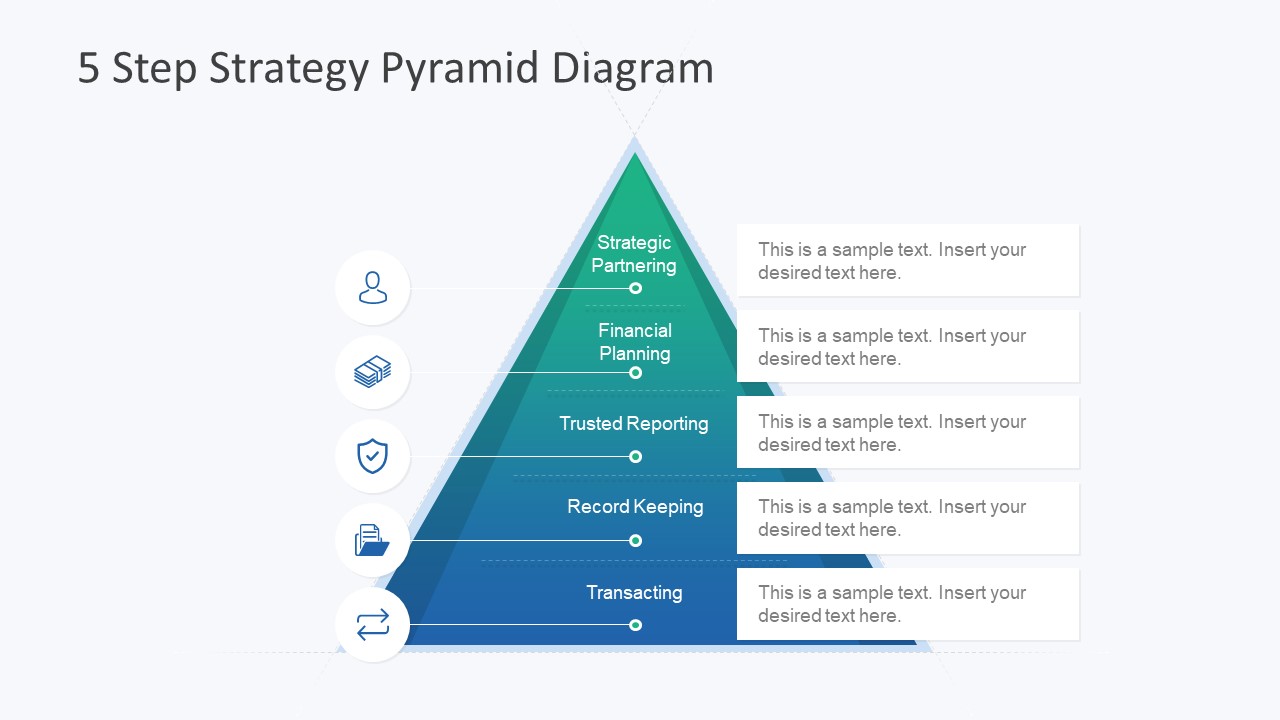The strategy pyramid is a visual tool to help you act on what your plan says you’re going to accomplish. Strategic alignment sounds simple: bring your activities and spending into logical harmony with your strategy.
What is a Strategy Pyramid?
Many organizations produce strategy documents that outline their top-level strategies and plans. But these documents rarely contain activities to accomplish the strategies and plans. Many companies struggle to align their tactical plans and budget with the higher level strategies and plans. The strategy pyramid illustrates the strategic behaviors that are required in order to achieve the strategies and plans on the next level. Every company has three levels of plans, each consisting of logically nested plans. The first level of plans act as a blueprint for a company’s future. The second level plans guide how a company will implement its strategic objectives and build its capabilities to execute its strategy. The third level plans help you get all the appropriate activities in place to ensure activities are in line with the strategies.
Before we go into details, look at the image of the strategy pyramid. The rest of this blog is a detailed explanation of each part of the pyramid.
Step 1: Identify the Strategies
First you must know what your strategies are. Strategies are your end-state objectives, the future outcomes you intend to achieve.
Step 2: Identify the Strategic Objectives
Strategic objectives are the key tasks that need to be accomplished to achieve your strategies. These are the key outcomes you need to achieve these strategies to get to their end-state. Strategic objectives are not the same as departmental goals. In each strategic objective, you must identify the departments that contribute to achieve that objective.
Step 3: Identify the Activities
Activity is the tactical programs, projects and tasks necessary to accomplish a strategic objective.
Step 4: Identify the Capabilities
True strategic alignment of activities and spending requires capabilities in your organization. A capability describes a set of skills, knowledge, systems, or tools that you need to accomplish your strategic objectives. The three basic types of capabilities are functional, core and project. Lines or boxes can be added to the levels that are missing them. For example, did you create performance measures for each strategic objective?
Step 5: Identify the Support Processes
Support processes are the activities that are not directly related to achieving your strategic objectives, but they are important to ensure the activities and capabilities are in alignment and enable the company to achieve its objectives. Examples of support processes are budgeting, resource allocation, or recruitment.
Step 6: Add the Lagging Indicator
Lagging indicators are the outcome metrics that are used to evaluate the performance of your strategic objectives. The most common example of a lagging indicator is a financial metric like sales, profit or market share. A lagging indicator should be placed at the bottom of the level of plan it describes.
Step 7: Add the Backward Feedback
Earlier we said that if activities are planned at the time of strategy development, they will be aligned with the first level of strategies and plans. But since the activities and plans are developed further from your strategic objectives, spending and managing the spending are more difficult the further away they are from actual achievement of the strategies and goals. In organizations where the strategies and plans are created last, activities and spending tends to be less aligned with strategies and plans. We call this phenomenon backward feedback. The backward feedback is the guidance you can give your organization about spending and activities.
Step 8: Wait… Evaluate, Adopt, Adjust and Repeat
It is hard to get things exactly right the first time. Even if you have everything planned, you will need to implement your strategy and modify your spending. This will require patience and deliberate reflection. First, let’s discuss the required activities for evaluating, modifying, and adjusting your strategies and plans. They are:
Evaluating
Once you’ve identified your strategies and plans, you need to evaluate if they’re aligned with your capabilities and resources. If you find something wrong or off, modify or adjust your strategies and plans so they’re on track. This evaluation of your strategies and plans should occur at least annually and should be a part of your planning process. This evaluation creates a positive feedback loop enabling your company to be agile.
Modifying
If you find something wrong, you must make modifications or adjustments to your spending. Modifications are changes that will make your spending more effective. After evaluating the effectiveness of your spending, you can make changes to your activities or projects. But if something is doing the job, don’t mess with it. If an activity is working, don’t change it. But it’s hard not to change things. At Kraft, we did a post-mortem study analyzing our failed Oreo launch. We found that our marketing and product development did not align with our capabilities. Adopting our capabilities were much more expensive than the actual expenses that ignited that failure.
Adjusting
This is the preferred way. The reality is that even if you’ve planned all the right things, there will be changes in your organization and the external environment. There will be unforeseen delays and problems that will cause you to adjust your spending. Use the information you’ve learned from your evaluation and modify your plans and activities to align them with your strategy.
Evaluate your ability to modify and adjust your spending. Use measurements like the strategy execution score (SES) to measure the effectiveness of your strategies and spending. The goal is to increase your SES so that you are able to adapt to changes faster. This forces your organization to predict the future and get everything off paper and into a computer. Develop the processes that enable you to measure the SES after the project is done.
Now that we’ve discussed the required activities for evaluating, modifying, and adjusting your strategies and plans, let’s take a deeper dive into each one.
Evaluating
Evaluation is about making sure your strategies and plans are working. If they aren’t working, you need to evaluate what went wrong. If you evaluate and find out that something is wrong, you need to evaluate the value provided and the ROI for each activity and spending line item. Use the strategy execution score (SES) to measure the effectiveness of your strategies and spending. The SES should be used to evaluate your strategic objectives, core capabilities, project and functional capabilities.
Modifying
The goal of modification is to increase the value of an activity while reducing cost. The first thing you need to do is consider the resources you have available. Look at the different ways you can accomplish your strategic objectives with the resources you have already. For example, instead of a strategy objective to build a new distribution center, you might consider better ways to utilize the existing resources you have, such as renting space in a warehouse or third-party logistics company. Reduce the cost of your activities by considering all of your available options before deciding which best fits your objectives.
Adjusting
You’ve planned everything and then, suddenly, disaster strikes. Earlier we talked about “readjustment” in the Strategy Execution Score (SES). Let’s consider how to approach this type of adjustment. Businesses seldom stay on the exact plan. There will be adjustments along the way. This is the question you need to ask in order to ask for resourcing: “In what state would you not proceed with this project?” If the project’s likely outcome is a “go” in your case, then you will proceed. If there is a possibility that the outcome could be a “no go,” then you should analyze how to proceed. You may need to go to the executive level to get the appropriate resourcing.
When you adjust your spending, you are reallocating resources to a different project. The best way to make your spending more effective is to modify your strategies and plans. It is very unlikely that your best strategies and plans will survive long enough to create value. You need to monitor your strategies regularly and make changes accordingly. Modifying your strategies and plans will align your spending with your strategic objectives.
When you decided to close or open a store, you put the resources on or off the list. The process of evaluation, modifying and adjusting your strategies and plans will enable an organization to be agile.
Following the S.M.A.R.T. goal setting methods will ensure that your New Year’s resolutions stick.
S-specs and deliverables should consist of:
M-mission statement: As you create your strategic plan and break it down into actionable steps, you will come up with milestones. Use these as milestones for yourself to check your progress periodically. A great way of accomplishing your goals is to evaluate and bring them back in a monthly basis. The focus should be on the purpose of the milestone, what it’s going to be used for, and how to measure its success.
A-assessment: The assessment is a detailed review of your S-specs and activities. This is an opportunity to evaluate your strategy execution. The results of the assessments can be used to modify your plans.
S-stretch: Each year, each strategy you have must have a stretch goal, a S-sprint goal, a S-sprint goal, and S-step goal and a S-step goal. The stretch goal is your S-sprint goal. The S-sprint goal is a one-year goal. The S-step goal is a one-quarter goal. The execution of each goal can be used to evaluate the progress. The plan should include milestones in each quarter that outline the activities that will make up the strategy. You’ll be able to then analyze how this is going.
R-review: Assess the different paths to each group of goals. How will you accomplish the goals? How are you going to achieve the priorities? What will be the milestones? When you have the plan, what is your contingency plan? Create a time frame for each activity and objectives. Use this time frame to measure your progress. Try to improve the time each quarter so that you’re getting faster and faster.
T-time: Use a time schedule. It is important to set a timeline for everything, so that you can measure your progress every eight weeks. Track the time spent on different activities. List the activities you will complete this quarter, month, and week.











